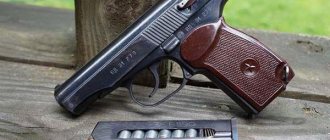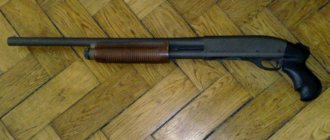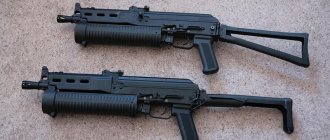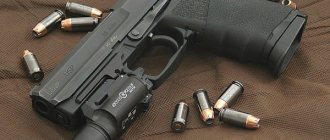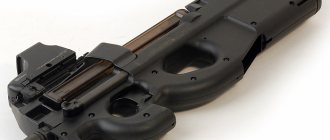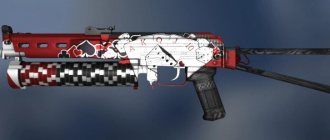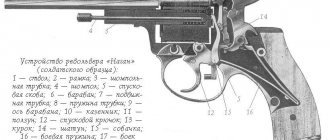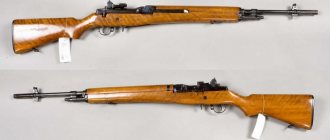"Swift" is not of the highest flight
Attempts to develop a pistol that would replace the good old Makarov led at the beginning of the new century to the adoption of several new models at once. Alas, none of the first wave of applicants was able to meet all the requirements of the military and police. This led to new proposals from gunsmiths. One of the most interesting new products of the “second wave” was the Russian-Italian pistol “Strizh”. What are the prospects for these weapons in Russian law enforcement agencies?
For several generations of Soviet people, the words “pistol” and “Makarov” became practically synonymous. Some in the service had the opportunity to meet with old “Nagans” or TTs, as well as with much rarer PSM or APS. Other diversity remained for isolated cases of foreign-made award weapons, museums, cinema, reference books and - in the worst case - criminal trafficking.
"Makarov" - without exaggeration, a pistol of the era
It must be said that the Makarov-designed pistol (PM) coped well with the role of the country’s main hand-held short-barreled weapon. For both army officers and most police officers, a pistol was more of a status item, completely replaceable in a holster with a sandwich or a couple of cucumbers. At the same time, the pistol was distinguished by its reliability, often enduring rather barbaric operating conditions, and in the conditions of the USSR, eight rounds of 9x18 mm cartridges were more than enough for most possible combat situations. A shootout with a well-armed gang in bulletproof vests by “precinct Aniskin” could only be seen in a nightmare after watching a foreign action movie.
Heirs of the Makarov pistol
The situation changed radically after 1991. The rampant crime in the “dashing 90s” made police patrols with shortened versions of the Kalash - AKS-74U - an everyday reality. However, the “stub” or “bastard,” as this machine gun was called among other nicknames, still remained a fairly large weapon, not very suitable for concealed carry. In addition, the energy of a powerful army cartridge when shooting in urban conditions was clearly excessive and dangerous. The “organs” obviously needed modern compact weapons with a large-capacity magazine and good penetration: the body armor worn by criminals was often of better quality than that of law enforcement officers. Similar requirements appeared in the army.
The Makarov pistol, even after upgrading to the PMM level with 12 reinforced 9x18 mm cartridges, did not reach the desired requirements. The result of a rather long competition under the heading “Rook”, started back in the USSR in 1990, was the adoption of three new pistols into service in the early 2000s. These were designs by V. A. Yarygin (PYa), V. P. Gryazev and A. G. Shipunov (GSh-18) chambered for 9x19 mm cartridges, both Western and domestic, and designs by P. I. Serdyukov ( SPS or SR-1 "Gyurza") chambered for special domestically developed 9x21 mm cartridges.
A triumvirate of competitors - heirs of the Makarov pistol. From left to right: Gryazev and Shipunov GSh-18 pistol, Serdyukov SR-1 pistol, Yarygin PYa pistol (https://karden.livejournal.com)
The adoption of three systems with similar tactical and technical characteristics and purpose in this case may indicate that none of the listed pistols demonstrated clear superiority over competitors. Of course, official information on the results of competitive testing and operation of new pistols is not yet publicly available, but the private opinions of individual users “in uniform” vary quite a bit in assessment. For the most part, they belong to the PYa and GSh-18, since the SR-1 is less common, and a special cartridge complicates matters even more: the first two pistols at least allow active training with the now quite cheap 9x19 mm cartridges now produced by Russian cartridge factories for export purposes. You can also partially form an opinion about the PYa based on the operating experience of its “civilian” version - the Viking pistol.
Also, indirect evidence of the “dampness” of new pistols can be the fact that the Ministry of Defense of the Russian Federation purchased Austrian Glock 17 pistols in 2013. Glocks were also spotted from special units of the FSB.
Victim of “administrative resource”
And against the backdrop of this “pistol drama” in 2012, the private Italian-Russian company Arsenal Firearms presented its development at the arms exhibition in Nuremberg - a pistol called “Strike One”, also known as “Strizh” for the Russian market. The new pistol was fully in line with the latest trends in “shooting fashion”: a frame made of polymer material, only an automatic safety, a double-row large-capacity magazine, a magazine neck with inclined internal surfaces to facilitate loading. The barrel locking scheme used was quite original - with a short stroke and locking with a descending cylinder. This made it possible to place the barrel as low as possible, which had a positive effect on reducing the toss when firing. In particular, the Arsenal Firearms advertising video clearly demonstrated that of all the pistols that took part in the test (Strike One and seven others, including the Glock 17 and HK USP), it was their weapon that demonstrated the smallest jump angle.
Strike One, also known as Swift, is fashionable and modern (https://arsenalfirearms.ru)
Even at the beginning of its career, the pistol was positioned as a weapon both for the commercial market and as a possible candidate for adoption by Russian security forces. But if Strike One’s promotion to Western markets is more or less taking shape and the pistol began to be sold in Europe, and in 2015 received permission to export to the United States, then the adoption into service in the Russian Federation somehow did not work out. According to publicly available information, the pistol was tested at TsNIITOCHMASH and failed. This is what the general director of this research institute, Dmitry Semizorov, said in an interview:
“...The pistol actually fired more than 4,000 rounds at our range and under normal conditions. There were no delays; it met the documentation requirements for the safety of handling it under normal conditions. When the pistol was dropped tested, even in sub-zero temperatures, there was no separation of the bolt or any breakage. There was no separation of the magazine, etc. However, cracks appeared in the area of the pistol handle...
When shooting at sub-zero temperatures, at different declination angles, etc., the Swift also fired without delays or complaints... except for the appearance of the same cracks. But when working under special conditions, that is, when working on dry parts, when working without cleaning and lubrication for five days and when dusty, the gun “acquired” such a large number of delays that it did not satisfy the requirements of the military customer in principle ... "
As a result, the issue of adopting the Swift into service and launching its production in Russia has stalled for now. With this, the official part of the article can be completed and the author’s personal opinion about the pistol and the situation around it can begin.
Does Swift have a chance of success?
Firstly, it is worth noting that the situation when verification tests are carried out by a structure offering its own competing sample is quite strange. Meanwhile, one of the new Russian pistols mentioned above, namely the SR-1 designed by Serdyukov, was developed and produced precisely at TsNIITOCHMASH. Moreover, in this case, the management of Arsenal Firearms will not be the first to be offended. Back in 1942, the People's Commissar of the People's Commissariat of Armaments D.F. Ustinov wrote angry letters in the spirit: “Where did you find such brutal operating conditions?” The letters did not help, and the sample was adopted not by G.S. Shpagin, an employee of the People’s Commissariat of Armaments, but by A.I. Sudaev, an employee who conducted tests at the small arms test site (for details, see the article “Shpagin vs. Sudaev”).
It is difficult to judge from the face of the Russian Prime Minister his impressions of the shooting from the Swift.
Note that there is also no information about passing such tests, for example, with Glocks.
Secondly, as practice shows, the operating conditions, as well as the tasks of a mass-produced army pistol, a police pistol or weapons of a few elite special forces are quite different. Of course, ideally it would be nice to have a model that would be reliable from the bottom of the Mariana Trench to the top of Everest, and would be accurate, lightweight, ergonomic, and also technologically advanced and cheap. But in reality, as a rule, to achieve high performance in one area, you have to sacrifice something else.
In the meantime, Strike One has a chance of market success rather in the niche of a sports pistol. The European retail price of 750 euros (according to the website https://www.ipscstore.eu) makes competition with the Glock 17, which is a hundred euros cheaper, or “regular” modifications of the Czech CZ-75, located in approximately the same price niche, doubtful. On the other hand, the “sports” Glock 34 already costs more than 800 euros, and the price of the sports versions of the “siskins” exceeds a thousand.
“Swift” in a fashionable “carbine body kit” - the pistol is enclosed in a metal case with a folding stock, a front handle, equipped with Picatinny rails and a collimator sight (https://arsenalfirearms.ru)
Unfortunately, the “Russianness” of relatively short-barreled weapons can be more of a hindrance than a help, unless we are talking about old models, most often purchased for collection purposes. If in the early 90s of the last century the memory of the high quality of weapons manufactured in the USSR itself replaced any advertising campaign, now the situation is reversed. In particular, the above-mentioned civilian version of Yarygin’s pistol, the Viking, especially in the first batches, caused a lot of disappointment among its owners - both with its “floating” workmanship and after-sales service, or rather the lack thereof.
Strike One, which the author had the opportunity to meet, was purchased less than a year ago. The firing rate at this point was about 5,000 rounds - a fairly average figure for a weapon of a regularly training shooter. The pistol’s flip turned out to be quite low, but it’s hard to say whether it will be that way for any shooter, since people’s palms are different. Rather, we can say that the pistol quickly returns to the aiming line after firing. The pistol did not demonstrate any extreme reliability, however, most of the problems that arose were more related to “budget” cartridges than to design flaws.
An obvious, although not having any real practical value, advantage of a pistol with a polymer frame is a wide range of colors (https://arsenalfirearms.ru)
But familiarization with the design during the cleaning process allows you to notice: the gun loves and needs care, and the complex shape of the parts contributes to the deposit of carbon deposits inside and also makes it difficult to get rid of it. For sports or “police” work in urban conditions, this is not a very critical indicator, but “Swift” is unlikely to succeed in becoming “one warrior in the field” in its current form.
Strizh pistol cartridge caliber 9 mm. Device. Weight. Sighting range
Strizh (export name AF-1 Strike One) is a hammerless self-loading pistol, developed by the Italian-Russian private company Arsenal Firearms. The Strizh pistol is intended both for the armed forces and law enforcement agencies, as well as for shooting sports and self-defense of citizens. The AF-1 Strike One pistol, intended for the foreign arms market, is produced in Italy in four calibers - 9x19 mm, 9x21 mm IMI, .357 SIG and .40 S&W.
